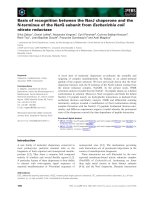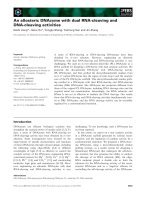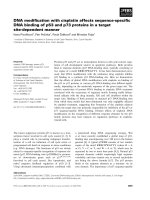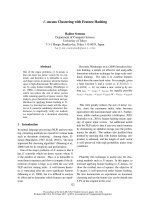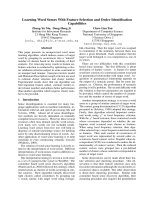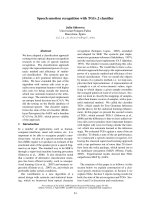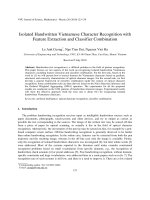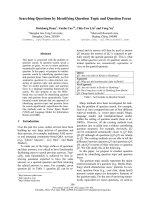Báo cáo " Isolated Handwritten Vietnamese Character Recognition with Feature Extraction and Classifier Combination " docx
Bạn đang xem bản rút gọn của tài liệu. Xem và tải ngay bản đầy đủ của tài liệu tại đây (300.91 KB, 17 trang )
VNU Journal of Science, Mathematics - Physics 26 (2010) 123-139
123
Isolated Handwritten Vietnamese Character Recognition with
Feature Extraction and Classifier Combination
Le Anh Cuong
*
, Ngo Tien Dat, Nguyen Viet Ha
University of Engineering and Technology, VNU, E3-144 Xuan Thuy, Cau Giay, Hanoi, Vietnam
Received 5 July 2010
Abstract. Handwritten text recognition is a difficult problem in the field of pattern recognition.
This paper focuses on two aspects of the work on recognizing isolated handwritten Vietnamese
characters, including feature extraction and classifier combination. For the first task, based on the
work in [1] we will present how to extract features for Vietnamese characters based on gradient,
structural, and concavity characteristics of optical character images. For the second task, we first
develop a general framework of classifier combination under the context of optical character
recognition. Some combination rules are then derived, based on the Naive Bayesian inference and
the Ordered Weighted Aggregating (OWA) operators. The experiments for all the proposed
models are conducted on the 6194 patterns of handwritten character images. Experimental results
will show the effective approach (with the error rate is about 4%) for recognizing isolated
handwritten Vietnamese characters.
Keywords: artificial intelligence; optical character recognition; classifier combination.
1. Introduction
The problem handwriting recognition receives input as intelligible handwritten sources such as
paper documents, photographs, touch-screens and other devices, and try to output as correct as
possible the text corresponding to the sources. The image of the written text may be sensed off-line
from a piece of paper by optical scanning, so actually it lies in the field of optical character
recognition. Alternatively, the movements of the pen tip may be sensed on-line, for example by a pen-
based computer screen surface. Off-line handwriting recognition is generally observed to be harder
than online handwriting recognition. In the online case, features can be extracted from both the pen
trajectory and the resulting image, whereas in the off-line case only the image is available. Firstly,
only the recognition of isolated handwritten characters was investigated [2], but later whole words [3]
were addressed. Most of the systems reported in the literature until today consider constrained
recognition problems based on small vocabularies from specific domains, e.g., the recognition of
handwritten check amounts [4] or postal addresses [5]. Free handwriting recognition, without domain-
specific constraints and large vocabularies, was addressed later in a some papers such as in [6, 7]. The
recognition rate of such systems is still low, and there is a need to improve it. There are a few related
______
*
Corresponding author. Tel.: 84-902134662
E-mail:
L.A. Cuong et al. / VNU Journal of Science, Mathematics - Physics 26 (2010) 123-139
124
studies for Vietnamese, such as [8] for recognizing online characters and [9] for recognizing off-line
characters. As one of the beginning studies of handwritten recognition for Vietnamese, in this paper
we just consider the off-line recognition and focus on the isolated character recognition.
There are two important factors which most affect the quality of a recognition/classification
system (among the methods which follow machine learning approaches). They include the features
extracted from the data (i.e. which kinds of features will be selected and how to extract them) and the
machine learning algorithms to be used. In our opinion, feature extraction plays the most important
role for any systems because it provides knowledge resources for those systems. For the work of text
recognition, feature extraction aims to extract useful information from input images and represents the
extracted information of a image as a vector of features. Because Vietnamese has a diacritic system
that forms much similar character groups, so discriminating these characters is very difficult. To
extract features for the work of recognition we will focus on the main characteristics forming the
difference between them. Encouraging by the studies in [10, 1] we will use the three kinds of features
including gradient, structural, and concavity features. This approach is suitable for applying to images
which have different sizes, and it has been shown effective for Arabic as presented in [10, 1]. In this
paper we will present in detail how to extract these features for Vietnamese characters. Different from
previous studies these kinds of features will be investigated as separate feature sets as well as the
combination set. In addition, these feature sets will be also used in various machine learning models
including classifier combination strategies/rules. All these works aim to find out the appropriate model
for Vietnamese character recognition.
In addition, for the aspect of classifier combination, different from previous studies, this paper
applies some combination rules which are new to the problem of character recognition. It is also
important that these rules are interpreted in a general framework of classifier combination, and then
derived under OWA operators and Naive Bayesian inference. This helps to understand the meaning of
the obtained combination rules and to discuss the appropriate obtained results of the recognizing. In
addition, we also investigate various kinds of individual classifiers, one is based on different
representations of features and the other based on different machine learning algorithms. Note that beside
combination rules we also investigate effectiveness of the three machine learning algorithms including
neural network (NN), maximum entropy model (MEM), and support vector machines (SVM). Among
them support vector machine will be shown as the very effective method for this work.
The rest of the paper is organized as follows. Section 2 presents related works. Section 3 presents
Vietnamese characters. Section 4 presents feature extraction for three kinds of them including
gradient, structural, and concavity ones. The classifier combination strategies/rules are presented in
section 5. All our experiments and discussions are presented in section 6. Finally, we summarize the
obtained results in section 7.
2. Related Works
As well known, the researches in OCR can be divided into two approaches: template matching and
structure analysis. Template matching is done by taking the total sum of the differences between each
sampled value and the corresponding template value, each of which is normalized. The template
matching process can be divided into two processes: inputting the shape on template and measuring
L.A. Cuong et al. / VNU Journal of Science, Mathematics - Physics 26 (2010) 123-139
125
the degree of coincidence between the input shape and the generated template. Concurrently, in [11]
the authors firstly design a feature vector for representing boundary point distances from the center of
gravity of the characters and then derive models (i.e. templates) for each character. The classification
is performed using the Euclidean distance between the test characters and the generated models.
Currently most studies consider the task of optical character recognition as a classification
problem. They firstly represent the image of each character/word as a set of features, and then use a
machine learning method to train a classifier. Therefore, the problems here in this approach is how to
extract useful features and how to design effective machine learning methods. There are some well-
known machine learning algorithms have been used, such as neural networks [12, 13], hidden markov
model [13, 1], graph-based method [10]. Note that in this paper we will investigate the three machine
learning algorithms NN, SVM, and MEM, which have shown their effectiveness for many pattern
recognition problems.
As observed in studies of pattern recognition systems, although one could choose one of learning
systems available based on the analysis of an experimental assessment of these to hopefully achieve
the best performance for the pattern recognition problem at hand, the set of patterns misclassified by
them would not necessarily overlap [14]. This means that different classifiers may potentially over
complementary information about patterns to be classified. The research domain of multiple classifier
systems (MCS) examines how individual classifiers can be combined to obtain a better classification
system. As well known there are two main issues in MCS research: the first issue is how the individual
classifiers are generated, and the second is how those classifiers are combined. It is straightforward to
apply MCS methods to the problem of handwriting recognition. There are many published studies of the
such approach. For example, in [15] a multilayer perceptron is trained to classify handwritten numerals.
For each pair of numerals that is likely to be confused a support vector machine is trained. If the two best
classes output by the multilayer perceptron are the digits of such a pair, the specialized classifier is
invoked. Otherwise the best class of the multilayer perceptron is output. In [16] a rule-based classifier is
serially combined with four Hopfield neural networks, which are only used when the first classifier
rejects the input. The task of the first neural network is to select one of the other three as the final
classifier. This system was also used for recognition of handwritten digits. For handwritten word
recognition, using Hidden Markov Models have become a standard method. Consequently, combinations
of HMMs with other classifiers have been proposed. In [17] an HMM classifier is combined with a
pattern matching classifier. A holistic classifier to reduce the vocabulary for an HMM classifier is
described in [18]. More recently, a number of studies are interested in apply techniques in classifier
combination strategies for the problem of handwritten recognition, such as [19-22].
It is worth to emphasize that in this paper we will follow a different approach of MCS for
handwriting recognition. We will first formulate a general framework of classifier combination and
then derive some combination rules based on OWA operators and Naive Bayesian inference, which
help to understand the underlying meaning of the used combination rules. These rules are then applied
to the Vietnamese handwriting recognition using the individual classifiers which are built from the
most effective algorithms (including SVM, NN, and MEM).
3. Vietnamese characters
The Vietnamese alphabet is the current writing system for the Vietnamese language. It is based on
the Latin alphabet with some digraphs and the addition of nice accent marks or diacritics - four of
them to create additional sounds, and the other five to indicate the tone of each word. The many
L.A. Cuong et al. / VNU Journal of Science, Mathematics - Physics 26 (2010) 123-139
126
diacritics, often two on the same letter, make written Vietnamese easily recognizable. The Vietnamese
alphabet consists of 29 letters, including:
- The 26 letters of the English alphabet except f, j, w, and z.
- Seven modified letters using diacritics đ, ă, â, ô, ơ, ư
In addition, Vietnamese is a tonal language with 6 tones. These tones can be marked on the letters
a ă â e ê i o ô ơ u ư y as follows:
1. level (không dấu) a ă â e ê i o ô ơ u ư y
2. high rising (dấu sắc) á ắ ấ é ế í ó ố ớ ú ứ ý
3. low/falling (dấu huyền) à ằ ầ è ề ì ò ồ ờ ù ừ ỳ
4. dipping-rising (dấu hỏi) ả ẳ ẩ ẻ ể ỉ ỏ ổ ở ủ ử ỷ
5. high rising glottalized (dấu ngã) ã ẵ ẫ ẽ ễ ĩ õ ỗ ỡ ũ ữ ỹ
6. low glottalized (dẫu nặng) ạ ặ ậ ẹ ệ ị ọ ộ ợ ụ ự ỵ
Therefore, excepting special symbols such as comma, colon, stop, …, the number of isolated
letters in Vietnamese is 93 including 26 English alphabet letters, 7 diacritic letters, and 12 letters
(each has 5 tones).
In this work we try to recognize these separate letters. Note that to recognizing each letter there are
normally two options. In the first option, each letter is treated as a completed unit/pattern to be
recognized. In the second one, the complex letters which contain diacritic or tones or both of them will
be recognized in a different way. Each letter is firstly divided into three separate parts: the tone part,
the diacritic part, and the remain is a normal letter. Each part is recognized separately and then their
results are combined to obtain the whole letter. However, for handwritten letter, it is so difficult to
separate these parts. That is because they are written in a flexible style and usually stick together.
Therefore, in this work, we choose the first option, and we will extract features for that it can express
characteristics of all the three parts. It is also worth to note that our approach in this paper is far
different from previous studies on Vietnamese handwritten recognition [9, 23] on both aspects of
feature extraction and classifier combination.
4. Feature extraction
4.1. Gradient feature extraction
The method of gradient feature extraction will detect features which stand for direction of
boundary pixel of the image. These extracted features are represented by a gradient vector. This vector
expresses the velocity when changing image pixel value to directions x and y (i.e. vertical axis and
horizontal axis).
With an image which its pixels are expressed by a grey value function
(; )
fxy
, the gradient vector
at pixel
(; )
xy
is computed as in the following formula:
[, ] [/ ,/]
fGxGyfxfy
(1)
Magnitude of the gradient vector at pixel
(; )
xy
is computed as:
Magnitude(∇f (x, y)) = [G
2
x + G
2
y]
1/2
(2)
L.A. Cuong et al. / VNU Journal of Science, Mathematics - Physics 26 (2010) 123-139
127
Fig. 1. An Example of gradient feature extraction.
Fig. 2. Directions and Neighbors of a pixel X.
Direction of the gradient vector at pixel (x, y) is computed as:
1
(; )tan
Gy
xy
Gx
a
(3)
The core of this method is finding out directional frequencies of image boundary pixel. We can
describe this algorithm by four steps as: (1) Finding a bounding box around the image to eliminate
white space containing no information and decrease computing cost. (2) Computing gradient map
about direction and magnitude. The gradient maps are computed by firstly convolving two Sobel
operators on the bounded image. These operators approximate derivatives at each pixel to x and y
directions. And then compute the direction and magnitude of the gradient vector at each pixel. (3) We
only take care about pixels lying on the image boundary where magnitude of gradient vector exceeds a
threshold. If r(i; j) > then pixel at (i; j) is a boundary pixel. (4) We design that the direction of the
gradient ranges from 0 to 2 ∏ radian. For each boundary pixel, this range is divided into twelve radian
parts. Divide the bounded image into 4x4 equal parts. In each part, a histogram is calculated in each
direction at every pixel. One threshold is set to the histogram and feature is on if corresponding
counting number is greater than the threshold.
Finally, we collect 192 gradient features. For example, the figure 1 illustrates an example when
finding 12 gradient features in 8-th part of a image of the character ‘A’.
4.2. Structural feature extraction
Structural features bases on the gradient map to find out short stroke types in the image. As
presented in [1], there are 12 structural feature extraction rules (see Figure 3). These rules manipulate
on the eight neighbors of each image pixel. Each rule examines a particular pattern of the neighboring
pixels for allowed gradient ranges. There rules correspond to the directions: horizontal stroke, vertical
L.A. Cuong et al. / VNU Journal of Science, Mathematics - Physics 26 (2010) 123-139
128
stroke, upward diagonal, downward diagonal, and right angle. Figure 2 shows how to determine and
index the directions and neighbors of a pixel.
And now to determine structural features, we divide the bounded image into 4x4 equal parts. In
each part, we consider the 12 rules in turn and count the number of pixels satisfying this rule.
Assuming we get 12 value a
i
where i = 0 … 11 and a
i
is number of pixel satisfying i
th
rule. Choosing a
threshold θ, we set the feature corresponding to a
i
to be true if a
i
> θ and false in otherwise. Each part
in 4x4 size grid brings us 12 features, so total number of features on the whole image is 192. For
example, Figure illustrates the result when finding 12 structural features in 8
th
part of the image.
Fig. 3. Rules for structural feature extraction.
Fig. 4. An example of extracting structural features.
L.A. Cuong et al. / VNU Journal of Science, Mathematics - Physics 26 (2010) 123-139
129
Fig. 5. Coast pixel density and horizontal /vertical stroke features.
4.3. Concavity feature extraction
The concavity features are used to determine the relationship between strokes at a large scale
across the image. Concavity features are belonging to 8 feature types: black pixel density, vertical
stroke, horizontal stroke, leftward concavity, rightward concavity, upward concavity, and downward
concavity. They are computed by placing a 4x4 sampling grid on the image. In each part of 4x4 size
grid, we count the number of pixels satisfying one of 8 characteristics above and choose a threshold to
determine whether 8 features in that part are on or off. These features consist of: one coarse pixel
density features, 2 large stroke features (horizontal and vertical strokes), and 5 concavity or hole
features.
For determining coarse pixel density feature, we first count the number of black pixel in each
part of sampling grid and choose a threshold θ to set this feature true or false. The figure 5 illustrate
that the number of black pixels in the 12
th
part of the image is 43 and threshold θ = 20 so this feature is
active (i.e. its value is 1).
For determining horizontal/vertical large stroke features we first denote c
1
be the length of
continuous horizontal black pixels in which the pixel is in, and denote r
1
be the length of continuous
vertical black pixels in which the pixel is in. Then, vertical large stroke and horizontal large stroke
features are determined based on the relation between c
1
and r
1
. For example, in this work, we choose
that if c
1
< r
1
× 0:75, then it is a vertical large stroke, and if c
1
> r
1
× 1:5, then it’s a horizontal large
stroke. See the figure 5 for an example.
For determining feature of concavity and hole, as clearly presented in [1] we design a convolving
operator on the image which shoots rays in eight directions and determines what each ray hits. A ray
can hit an image pixel or the edge of the image. A table is built to store the termination status of the
rays emitted from each white pixel of the image. The class of each pixel is determined by applying
rules to the termination status patterns of the pixel. Currently, upward/downward, left/right pointing
concavities are detected along with holes. The rules are relaxed to allow nearly enclosed holes (broken
holes) to be detected as holes. This gives a bit more robustness to noisy images. These features can
overlap in that in certain cases more than one feature can be detected at a pixel location. Figure 6 show
some features of concavity and hole.
Finally, we have 128 features in the model of concavity feature extraction.
L.A. Cuong et al. / VNU Journal of Science, Mathematics - Physics 26 (2010) 123-139
130
Note that some studies such as [1] use the combination of these three feature extraction methods. It
is useful for detect features ranging from local scale to large scale, from single pixel to multiple pixel
relationship. The set of these entire features are called GSC features (i.e. Gradient, Structural, and
Concavity). A GSC feature vector consists of 512 features. Note that in this paper, we will investigate
each of the three feature sets as well as the GSC feature set separately.
Fig. 6. Feature of concavity and hole.
5. Classifier combination strategies
5.1. Architecture of Multi-Classifier Combination
Classifier combination has been studied intensively in the last decade, and has been shown to be
successful in improving performance on diverse applications [14, 19, 22, 24]. The intuition behind
classifier combination is that individual classifiers have different strengths and perform well on
different subtypes of test data. Fig. 7 intuitively presents the architecture of multiple classifier
combination.
Fig. 7. Architecture of multiple classifier combination.
From this figure, we can see that the base classifiers (also called individual classifiers) can be
created based on the different feature spaces, different training datasets, or different models (machine
L.A. Cuong et al. / VNU Journal of Science, Mathematics - Physics 26 (2010) 123-139
131
learning algorithms). Note that by combining these different types, we can also create other set of
individual classifiers. Fig. 7 also shows the general process of applying classifier combination
strategies for a problem such as classification. That is, firstly the set of individual classifiers are built
and then they are used for detecting test examples. Outputs of these individual classifiers are then
combined using fixed combination rules or training combination rules to generate consensus decisions.
5.2. General framework of classifier combination
We first convert the optical character recognition (OCR) problem to the classification. Suppose
img is the image to be recognized. Let
1
, ,
R
DDD
be a set of classifiers, and let
1
, ,
M
Scc
be a set of potential labels (corresponding to characters need to be mapped). Alternatively, we may
define the classifier output to be a M-dimensional vector
,1,
() [(), , ()]
iiiM
Dimgdimgdimg
(4)
where d
i,j
(img) is the degree of “support” given by classifier D
i
to the hypothesis that img comes
from class c
j
. Most often d
i,j
(img) is an estimation of the posterior probability P(c
i
|img). In fact, the
detailed interpretation of d
i,j
(img) beyond a “degree support” is not important for the operation for any
of the combination methods studies here. It is convenient to organize the outputs of all R classifiers in
a decision matrix as follows.
1,11,
,1,
,1,
()()
() () ()
M
iiM
RRM
dimgdimg
DPimgdimgdimg
dimgdimg
(5)
Thus, the output of classifier D
i
is the i
th
row of the decision matrix, and the support for class c
j
is
the j
th
column. Combining classifiers means to find a class label based on the R classifiers outputs. We
look for a vector with M final degrees of support for the classes, denoted by
D(img) = [µ
1
(w), …, µ
M
(img)] (6)
where µ
j
(img)is the overall support degree obtained by combining R support degrees {d
1,j
(img), …,
d
R,j
(img)}from outputs of the R individual classifiers, under a combination operator ⊕, as presented in
the formula (7) below.
µ
j
(img) = ⊕ (d
1,j
(img), …, d
R,j
(img), for j = 1, …, M (7)
If a single class label of img is needed, we use the maximum membership rule: Assign img to class
c
k
iff
µ
k
(img) ≥ µ
t
(img); ∀t = 1, …, M. (8)
If we assume that each individual classifier D
i
is based on a knowledge source, namely f
i
, and then
when detecting characters for img, the classifier D
i
outputs a probability distribution over the label set
S, denote by
1
M
ji
j
Pcf
. In other word, to distinguish the individual classifiers we assume each
classifier D
i
is based on a knowledge source f
i
, and consequently we can represent d
i,j
(img) by the
posterior probability, P(c
j
|f
i
), or by following equation:
d
i,j
(img) = P(c
j
|f
i
) (9)
L.A. Cuong et al. / VNU Journal of Science, Mathematics - Physics 26 (2010) 123-139
132
Note that this representation is used for all types of generation of different individual classifiers
even though it is more appropriate for individual classifiers based on different feature spaces than
different machine learning algorithms.
Under a mutually exclusive assumption of a set F = f
i
(i = 1, …, R), the Bayesian theory suggests
that the image img should be assigned to class c
k
provided the a posteriori probability of that class is
maximum, namely
1
argmax, ,
jR
j
kPc
ff
(10)
That is, in order to utilize all the available information to reach a decision, it is essential to
consider all the representations of the target simultaneously.
The decision rule (10) can be rewritten using Bayes theorem as follows:
1
1
, ,
argmax
, ,
Rjj
j
R
PcPc
k
P
ff
ff
Because the value of P(f
1
, …, f
R
) is unchanged with variance of c
j
, we have
1
argmax,
Rjj
j
kPffcPc
(11)
As we see, P(f
1
, …, f
R
|c
j
) represents the joint probability distribution of the knowledge sources
corresponding to the individual classifiers. Assume that these knowledge sources are conditionally
independent, so that the decision rule (11) can be rewritten as follows:
1
argmax
R
jij
j
j
kPcPc
f
(12)
According to Bayes rule, we have:
jii
ij
j
PcP
Pc
Pc
ff
f (13)
Substituting (13) into (12), we obtain the Naive Bayesian (NB) Rule:
1
1
argmax
R
R
jij
j
i
kPcPc
f
(14)
It is worth to emphasize that we can consider NB rule as the NB classifier built on the combination
of all feature subsets f
1
, …, f
R
.
Product Rule
Like [14], if we assume that all prior probabilities P(c
j
) (j=1,. . . ,M) are of equal value, and then
we obtain the equation, as follows.
1
argmax
R
ij
j
i
kPc
f
(15)
The decision rule (15) quantifies the likelihood of a hypothesis by combining the a posteriori
probabilities generated by the individual classifiers by means of a product rule.
5.3. OWA operators
5.3.1 OWA Operators and derive combination rules
The notion of OWA operators was first introduced in [25] regarding the problem of aggregating
multi-criteria to form an overall decision function. A mapping
L.A. Cuong et al. / VNU Journal of Science, Mathematics - Physics 26 (2010) 123-139
133
F : [0, 1]
n
→ [0, 1]
is called an OWA operator of dimension n if it is associated with a weighting vector W = [w
1
, …, w
n
],
such that 1) w
i
∈ [0, 1] and 2)
i
i
w
= 1, and
1
1
, ,
n
nii
j
Faawb
where b
i
is the i
th
largest element in the collection a
1
, …, a
n
.
The fuzzy linguistic quantifiers were introduced by Zadeh in [26]. According to Zadeh, there are
basically two types of quantifiers: absolute, and relative. Here we focus on the relative quantifiers
typified by terms such as there exists, for all. A relative quantifier Q is defined as a mapping Q : [0,
1]
n
→ [0, 1] verifying Q(0) = 0, there exists r ∈ [0, 1] such that Q(r) = 1, and Q is a non-decreasing
function. For example, the membership function of relative quantifiers can be defined [27] as
0
if <
()if
if >
1
ra
ra
Qrarb
ba
rb
(16)
with parameters a, b ∈ [0, 1].
Then, Yager [25] proposed to compute the weights w
i
is based on the linguistic quantifier
represented by Q as follows:
(1)
i
ii
wQQ
nn
, for i = 1, …, n. (17)
5.3.2 OWA Operator Based Combination Scheme
Let us return to the problem of identifying the right character of a given optical image img of a
character as described above. Let us assume that we have R classifiers corresponding to R information
sources f
i
(or R different machine learning algorithms), each of which provides a soft decision for
identifying the right character of the optical image img in the form of a posterior probability P(c
k
|f
i
),
for i = 1, …, R.
Under such a consideration, we now can define an overall decision function D, with the help of an
OWA operator F of dimension R, which combines individual opinions to derive a consensus decision
as follows:
D(c
k
) = F(P(c
k
|f
1
), …, P(c
k
|f
R
)) =
1
R
ii
i
wp
(18)
where p
i
is the i-th largest element in the collection P(c
k
|f
1
), …, P(c
k
|f
R
), and W = [w
1
, …, w
R
] is a
weighting vector semantically associated with a fuzzy linguistic quantifier. Then, the fuzzy majority
based voting strategy suggests that the optical image img should be assigned to class c
j
provided that
D(c
j
) is maximum, namely
argmax()
k
k
jDc
j = arg (19)
As studied in [25], using Zadeh’s concept of linguistic quantifiers and Yager’s idea of associating
their semantics to various weighting vectors W, we can obtain many commonly used decision rules as
following.
L.A. Cuong et al. / VNU Journal of Science, Mathematics - Physics 26 (2010) 123-139
134
Max Rule First let us use the quantifier there exists which can be relatively represented as a fuzzy
set Q of [0, 1] such that Q(r) = 0, for r < 1/R and Q(r) = 1; for r ≥ 1/R. We then obtain from (17) the
weighting vector W = [1, 0,…, 0], which yields from (18) and (19) the Max Decision Rule as
argmaxmax()
ki
i
k
jPc
f
(20)
According to the quantifier-based semantics associated with this weighting vector [25], the max
decision rule states that a decision of labeling for example e should be made if there exists an
individual classifier supports that decision. In other word, the label selection of an example is followed
the decision of the best classifier or followed the decision that obtains the maximum degree of
supports from all the individual classifier.
Min Rule Similarly, if we use the quantifier for all which can be defined as a fuzzy set Q of [0, 1]
such that Q(1) = 1 and Q(r) = 0; for r ≠ 1 [25]. We then obtain from (17) the weighting vector W = [1,
0, …, 0], which yields from (18) and (19) the Min Decision Rule as
argmaxmin()
ki
i
k
jPc
f
(21)
Also, according to the quantifier-based semantics associated with W, the min decision rule states
that a decision of labeling for example e should be made if all individual classifiers support that
decision.
Suppose that the i
th
classifier supports class c
j
a degree d
i,j
(e), then it means this classifier opposes
a degree (1 – d
i,j
(e)) to c
j
. For each support degree d
i,j
(e) let we name its corresponding opposition is
'
,
()
ij
d
e
(e) then the min rule can be rewritten as follow.
'
,,
11
1 1
ˆ
argminmin1()argminmin()
RR
ijij
ii
jcjc
jdd
ee
(22)
With this presentation of the min rule, the class/label selection of an example is followed the
decision which minimums the opposition from all the individual classifiers.
Median Rule In order to have the Median decision rule, we use the absolute quantifier at least one
which can be equivalently represented as a relative quantifier with the parameter pair (0; 1) for the
membership function Q in (16). Then we obtain from (17) the weighting vector W = [1/R,…,1/R],
which from (18) and (19) leads to the median decision rule as:
1
1
argmax()
R
ki
k
j
jPc
R
f
(23)
6. Experiment
6.1. Experimental models
For the experiment, we will investigate various models including the models for generating
individual classifiers and the models for combining the individual classifiers. The machine learning
algorithms to be used include neural network (NN), maximum entropy (ME), and support vector
machine (SVM) which have shown their effectiveness for many classification/recognition problems.
From these three machines learning algorithms, by using with the four feature sets (including gradient,
L.A. Cuong et al. / VNU Journal of Science, Mathematics - Physics 26 (2010) 123-139
135
structural, concavity feature sets and the combination of them) we totally generate 12 individual
classifiers.
For classification combination, in section 4 we have presented various strategies including max
rule, min rule, median rule, and product rule. There are two main scenarios of generating
individual/base classifiers. In the first scenario, the individual classifiers are built based on different
views of the data. It means that for each representation of the optical image of a character we have a
base classifier. Concretely, we here consider the image under the three kinds of feature extraction:
gradient, structural feature, and concavity extraction, each of which corresponds to a feature set. Note
that we also integrate all these three feature sets for the overall representation (called GSC the feature
set) of each optical image. In the second scenario, base classifiers use the same presentation with
different machine learning methods (using NN, ME, and SVM).
In summary, we have four different sets of individual classifiers. For the first three sets of
individual classifiers, each of them bases on one algorithms and different feature sets (i.e. gradient,
structural, and concavity feature sets). The four set of individual classifier bases on one feature set (i.e.
the GSC set) and different machine learning algorithms (i.e. NN, ME, and SVM).
Fig. 8. Form for collecting data.
L.A. Cuong et al. / VNU Journal of Science, Mathematics - Physics 26 (2010) 123-139
136
6.2. Data preparation
Up to now there is no a standard database for this work. We therefore have built our self a
database for isolated handwritten Vietnamese character recognition. Firstly we design a form by which
a person can fill in the characters at specified places (see the figure 8). Secondly, after collecting these
filled forms we built a tool for extracting the specified characters. To do this work, we have used 188
students from the University of Engineering and Technology, Vietnam National University of Hanoi.
We have selected all 10 digits and 66 Vietnamese characters including upper and lower ones. After
discarding illegal forms we obtain 6194 patterns. Note that the images of characters are then shrunk to
28x28 grey images which are exported to database files in MNIST
1
format which are normally useful
for such the studies of text recognition. They are then divided into three sub-sets with 3716 patterns
for the training set, 1239 patterns for the development set, and 1239 patterns for the test set.
Table 1. Experimental results (show the error rates of recognition)
Individual classifiers Combination rules
Gradient Structural Concavity Median Max Min Product
ME 11.2% 12.4% 14.5% 7.6% 7.6% 8.2% 6.9%
NN 11.1% 11.1% 15.5% 7.1% 8.1% 9.0% 8.6%
SVM 7.0% 7.0% 10.3% 4.6% 5.7% 5.0% 4.5%
GSC 7.0%(ME) 5.9%(NN) 4.0%(SVM) 4.3% 4.5% 4.0% 4.3%
6.3. Experimental results and discussion
Table 1 shows all of our experimental results which contain the error rates for all individual
classifiers (generated by using various kinds of features and machine learning algorithms) and the
combination models. The first three columns stand for three feature sets including gradient, structural,
and concavity ones respectively. The next four columns stand for the combination strategies/rules
including median, max, min, and product rules respectively. The first three rows present the case when
individual classifiers are generated by using one machine learning algorithms with different features
sets as mentioned above. Note that the last row presents the case when individual classifiers using the
GSC feature set with different machine learning algorithm. From the obtained results we have the
following discussions.
- Regarding the first three rows of the table, when using the feature sets separately we can see that
gradient and structural feature sets have shown their similar effectiveness while using concavity
feature set gives lower accuracies (i.e. higher error rates). Specially using the combination rules on the
individual classifiers give better results in comparison with these individual classifiers. Among these
combination rules the product rule gives the best results (error rates are 6:9% and 4:5%) in two cases
and the median rule give the best result in the remain case (error rate is 7:1%). Note that the product
rule is generated based on the assumption that the resources used in individual classifiers are
independent with each other. From the way of feature extraction we can see that gradient features,
structural features, and concavity features seems to be independent with each other, therefore it has
shown the better results in most cases. The remaining case causes a difference may because the private
characteristic of NN doesn’t support the assumption of the product rule that all prior probabilities are
of equal value.
L.A. Cuong et al. / VNU Journal of Science, Mathematics - Physics 26 (2010) 123-139
137
- In the other aspect, when using the GSC feature set which is the combination of gradient,
structural, and concavity features we can see that the obtained classifiers give the best results in
comparison with using them separately, as shown at the last line of the table 1. Moreover, the support
vector machine algorithms showed that it is the best method for this work. For the combination rules
in this case, the min rule gets the best result and it is the same to SVM method (the error rates are
equal to 4:0%).
Note that in the related work [9], the authors used some kinds of features including horizontal,
vertical direction and the two diagonals of the optical images. These features are just a part of
structural features as we presented in section 3. Therefore our work of feature extraction is more
general than [9].
In summary the obtained results have shown that using GSC features gives low error rates. It
means that combine all the three kinds of features (including gradient, structural, and concavity ones)
will provide rich knowledge resources to recognize Vietnamese characters. The experiments also
affirm that using the proposed combination rules will give the best results for all the cases, especially
in the case we are having weak individual classifiers (when they uses separately feature sets). Even
that in the last case when the support vector model has shown the same result as using the min rule, in
general using combination strategies will provide us a safe way to obtain the best classifier. In some
situations in which we obtain weak classifiers, for example when we do not have enough training data
or do not have enough evidences then using combination is adequate to obtain a strong classifier.
Furthermore in our opinion, we can use an effective strategy that uses a development data set to
determine which one is the best among combination rules and individual classifiers.
7. Conclusion
To recognize isolated Vietnamese characters, this paper firstly investigated gradient, structural,
and concavity characteristics of the character images for feature extraction. These kinds of features are
used for the three machine learning algorithms: neural network, maximum entropy, and support vector
machines. The experimental results have shown that gradient and structural feature sets give the same
effect while concavity feature set gives higher error rate. Specially, the combination of these three
feature kinds gives the best result. From these result, when conducting experiment on NN, ME, and
SVM algorithm we obtain that SVM produces the best result.
Secondly, to investigate the effectiveness of applying classifier combination rules to this work, a
general framework for classifier combination has been proposed and then derived several combination
rules based on Naive Bayesian inference and OWA operators. These rules have been applied on
individual classifiers which are based on different feature sets or different machine learning
algorithms. The experimental results have shown the effectiveness of using the combination approach,
specially in the case when these individual classifiers lack of adequate knowledge resources. In
summary, using GSC feature set with SVM algorithm and classifier combination strategies have been
shown to be the appropriate solution for recognizing isolated handwritten Vietnamese characters. In
addition, by using a development set, we can decide which model is the most appropriate in a
particular context.
L.A. Cuong et al. / VNU Journal of Science, Mathematics - Physics 26 (2010) 123-139
138
Acknowledgments. The work in this paper was partly supported by the research project QG.07.25
granted by the Vietnam National University, Hanoi. We would like to thank all the project members
for their support.
References
[1] S.M. Awaidah, S.A. Mahmoud, A multiple feature/resolution scheme to Arabic (Indian) numerals recognition
using hidden Markov models, Signal Processing 89(6) (2009) 1176.
[2] C.Y. Suen, C. Nadal, R. Legault, T.A. Mai, L. Lam, Computer recognition of unconstrained handwritten
numerals, Proc IEEE 80(7) (1992) 1162.
[3] J.C. Simon, Offline cursive word recognition, Proc IEEE, 80(7) (1992) 1150.
[4] S. Impedovo, P. Wang, H. Bunke, Automatic Bankcheck Processing, World Scientific, Singapore, 1997.
[5] A. Kaltenmeier, T. Caesar, J. Gloger, E. Mandler, Sophisticated topology of hidden Markov models for cursive
script recognition. In Proc. of the Second Int, Conference on Document Analysis and Recognition, Tsukuba
Science City, Japan, (1993) 139.
[6] U.V. Marti, H. Bunke, Using a Statistical Language Model to Improve the Performance of an HMM-Based
Cursive Handwriting Recognition System Int’l, J. Pattern Recognition and Artificial Intelligence, vol. 15, No.1
(2001) 65.
[7] Alessandro Vinciarelli, Samy Bengio, Horst Bunke, Offline Recognition of Large Vocabulary Cursive Hand-
written Text Proceedings of 7th IEEE International Conference on Document Analysis and Recognition,
Edinburgh (2003) 1101.
[8] Nguyen Duy Khuong, Bui The Duy, Recognizing Vietnamese Online Handwritten Separated Characters,
Proceedings of the 2008 International Conference on Advanced Language Processing andWeb Information
Technology (2008) 279.
[9] Pham Anh Phuong, Ngo Quoc Tao, Luong Chi Mai, An Efficient Model for Isolated Vietnamese Handwritten
Recog-nition, International Conference on Intelligent Information Hiding and Multimedia Signal Processing 2008.
[10] J.T. Favata, Offline general handwritten word recognition using an approximate BEAM matching algorithm, IEEE
Transactions on Pattern Analysis and Machine Intelligence, 23 (2001) 1009.
[11] F. Al-Omari, Handwritten Indian numeral recognition system using template matching approaches, IEEE
International Conference on Computer Systems and Applications, Beirut (2001) 83.
[12] P.D. Gader, M. Mohamed, J.H. Chiang, Handwritten Word Recognition With Character and Inter-Character
Neural Networks, IEEE Trans. Sys.Man Cybernetics, vol. 27, No. 1 (1997) 158.
[13] M.Y. Chen, A. Kundu, J. Zhou, Off-Line Handwritten Word Recognition Using a Hidden Markov Model Type
Stochastic Network, IEEE Trans. on PAMI, vol. 16 (1994) 481.
[14] J. Kitter, M. Hatef, R. Duin, J. Matas, On combining Classifiers, IEEE Transactions on Pattern Analysis and
Machine Intelligence, Vol. 2 No. 3 (1998) 226.
[15] A. Bellili, M. Gilloux, P. Gallinari, An hybrid MLP-SVM handwritten digit recognizer, In Proc. of the 6th Int.
Conference on Document Analysis and Recognition, Seattle, USA, 2001, 28.
[16] L. Lee, N. Gomes, Disconnected handwritten numeral image recognition, In Proc. of the 4th Int. Conference on
Document Analysis and Recognition, Ulm, Germany, vol. 2 (1997) 467.
[17] K. Maruyama, Y. Nakano, Recognition method for cursive Japanese word written in latin characters, In Proc. of
the 7th Int. Workshop on Frontiers in Handwriting Recognition, Amsterdam, The Netherlands, 2000, 133.
[18] G. Kaufmann, H. Bunke, M. Hadorn, Lexicon reduction in an HMM-framework based on quantized feature
vectors, In Proc. of the 4th Int. Conference on Document Analysis and Recognition, Ulm, Germany, volume 2
(1997) 1097.
[19] Roman Bertolami, Horst Bunke, Ensemble Methods to Improve the Performance of an English Handwritten Text
Line Recognizer, Proceedings of the 2006 conference on Arabic and Chinese handwriting recognition, 265.
[20] Roman Bertolami, Horst Bunke, Multiple Classifier Methods for Offline Handwritten Text Line Recognition, MCS
2007, LNCS 4472, (2007) 72.
[21] S. Gunter, H Bunke, Optimization of Weights in a Multiple Classifier Handwritten Word Recognition System
Using a Genetic Algorithm, in Electronic Letters Computer Vision and Image Analysis 3 (1) (2004) 25.
L.A. Cuong et al. / VNU Journal of Science, Mathematics - Physics 26 (2010) 123-139
139
[22] Simon Gunter, Horst Bunke, Offline cursive handwriting recognition using multiple classifier systems on the
influence of vocabulary, ensemble, and training set size, Optics and Lasers in Engineering, 43 (2005) 437.
[23] Pham Anh Phuong, Some methods for effectively extracting features for Isolated Vietnamese Handwritten
Recognition, Journal of Science (Hue university), 53 (2009) 73. (in Vietnamese)
[24] D. Klein, K. Toutanova, H. Tolga Ilhan, S.D. Kamvar, C.D. Manning, Combining Heterogeneous Classifiers for
Word Sense Disambiguation, ACL WSD Workshop, (2002) 74.
[25] R.R. Yager, On ordered weighted averaging aggregation operators in multi-criteria decision making, IEEE
Transactions on Systems, Man, and Cybernetics, 18 (1988) 183.
[26] L.A. Zadeh, A computational approach to fuzzy quantifiers in natural languages, Computers and Mathematics
with Applications, 9 (1983) 149.
[27] F. Herrera, J.L. Verdegay, A linguistic decision process in group decision making, Group Decision Negotiation
(5) (1996) 165.

